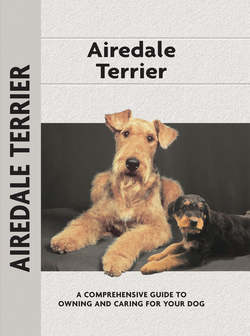Читать книгу Airedale Terrier - Bardi McLennan - Страница 11
На сайте Литреса книга снята с продажи.
MOVING ON
ОглавлениеAt the onset of World War I, the Airedale Terrier became England’s war dog, in part to overcome the stigma of enemy attached to the German Shepherd Dog (Alsatian). Shows were halted and pursuits of championships put on hold, but the breed’s military accomplishments in battle won it a permanent place in the hearts of the public. Word of mighty feats performed by Airedales at the front spread to America and, as a result, some of the best dogs in Britain were sold to the US for large sums of money. Among them were several of J. P. Hall’s Warland dogs, including Int. Ch. Warland Ditto, the aforementioned top sire who appeared in pedigrees of most leading kennels of the day.
AIREDALE VS. WELSH
Many breeders throughout the world breed both Airedales and Welsh Terriers, no doubt contributing to that persistently irritating query, “Is that a miniature Airedale?” To which, a common reply is, “No, that other dog is a giant Welsh!”
Welsh Terrier
If it seems odd that all of these great dogs were exported out of the UK, it is because top breeders in the British Isles have always sold their “good ones.” The reason given is that the British breeders are generally in it for life, often passing the kennels along to their offspring, whereas in other countries, show folk don’t always stay in breeding and showing as long. They are likely to give up if in five years they haven’t handled, bred or bought a Best in Show dog; or perhaps the care of dogs 365 days a year takes its toll. Breeders in Britain are not as competitive and, as perpetual optimists, they believe that the “perfect” pup is sure to be in the next litter.
One of the undesirable features agreed upon by all in the early years (along with light eyes and long ears) was the persistence of faded color and soft texture of the coat. After WWI, a dog named Ch. Mespot Tinker, found as a pup by A. J. Edwards, was a force in establishing what was wanted. He was highly acclaimed for his jet-black saddle and rich red tan jacket of the correct wire texture. Even more significant, he was prepotent for both, passing these traits along to his offspring. It seems that the striking deep color was what most attracted people to the breed.
A. J. “Towyn” Edwards was well known as an exceptionally fine breeder of both Welsh and Fox Terriers. And where do you suppose Mr. Edwards found Mespot Tinker? In Aberdovey, Wales—right where those small black and red Welsh Terriers had been for centuries! And from where (I’m delighted to add), according to historian J. L. Ethel Aspinall, came the contribution of the Welsh Harrier to the Airedale Terrier mix (Miss Aspinall grew up in Scotland and her affix, Llanipsa, was not Welsh, but merely her surname spelled backwards!).
Women were taking their place in the dog world. Mrs. M. Beamish-Levy, in addition to running her Ardross kennels, founded a training college for kennelmaids. George Oliver and his wife were both Airedale enthusiasts, with Mrs. Oliver founding the North of England Airedale Terrier Club in 1923. This of course continues, with significant numbers of women in the UK and all over the world breeding Airedales as well as grooming them and handling them in the show ring.
MOVIE STAR
Ch. Jokyl Bengal Figaro was a Hollywood film star, appearing in Walt Disney’s film The Ballad of Hector, followed by a dog-show career on the Continent before returning to England.
By the early 1920s, the breed had become too popular for its own good. Would-be breeders, who knew nothing about dogs, the breeding of them or the Airedale Terrier’s temperament or needs, took to producing them en masse. Their only goal was to profit from selling puppies. Their lack of integrity created a glut on the market and in shelters. Poorly bred and poorly raised, many of these dogs were aggressive, with atypical coats and ears (of course) and with a variety of health problems. This situation was particularly bad in the US. To this day, many uninformed people still consider the Airedale to be an aggressive guardian of his turf. So be it. No doubt that the misconception has deterred many an intruder!
By the end of the 1920s, the demand had dried up and the profiteers retreated. A number of concerned breeders assumed the task of eliminating the problems caused by uninformed over-breeding, as well as putting right the Airedale’s deteriorating public image. The comeback was slow but steady, and extremely gratifying. By the end of the 1930s, the Airedale Terrier once again stood as the undoubted “King of Terriers”—a sensible protector, willing worker, playful prankster and faithful friend.
During World War I, British troops used Airedales to carry messenger pigeons to a given point. Then the birds were released in order to communicate with troops under siege.
